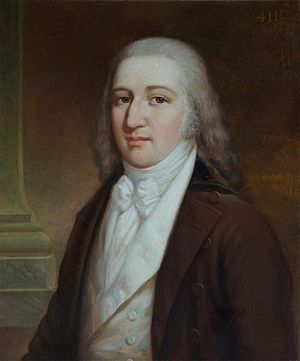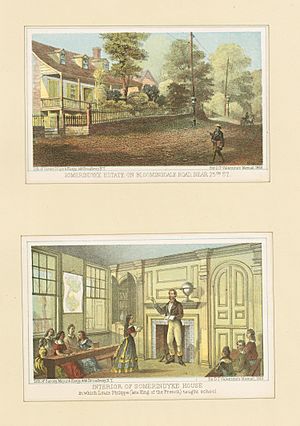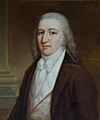Louis Philippe I facts for kids
Quick facts for kids Louis Philippe I |
|||||
|---|---|---|---|---|---|
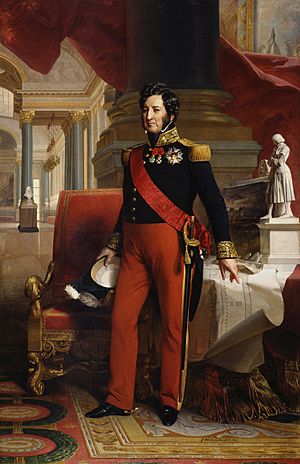
Louis Philippe, King of the French by Franz Xaver Winterhalter, 1841
|
|||||
| King of the French (more...) | |||||
| Reign | 9 August 1830 – 24 February 1848 | ||||
| Proclamation | 9 August 1830 | ||||
| Predecessor | Charles X (as King of France) |
||||
| Successor | Jacques-Charles Dupont de l'Eure (as President of the Provisional Government) |
||||
| Prime Ministers |
See list
|
||||
| Born | 6 October 1773 Palais Royal, Paris, Kingdom of France |
||||
| Died | 26 August 1850 (aged 76) Claremont, Surrey, England |
||||
| Burial | 1876 Chapelle royale de Dreux |
||||
| Spouse | |||||
| Issue see detail... |
|
||||
|
|||||
| House | Orléans | ||||
| Father | Louis Philippe II, Duke of Orléans | ||||
| Mother | Louise Marie Adélaïde de Bourbon | ||||
| Religion | Catholicism | ||||
| Signature | |||||
Louis Philippe (born October 6, 1773 – died August 26, 1850) was the King of the French from 1830 to 1848. He was the second to last monarch to rule France.
As a young man, Louis Philippe was known as the Duke of Chartres. He showed great bravery leading troops during the French Revolutionary Wars. By the time he was nineteen, he was a lieutenant general. However, he disagreed with the new French Republic when they decided to execute King Louis XVI.
In 1793, he had to flee to Switzerland because he was linked to a plan to bring back the monarchy. His father, Louis Philippe II, Duke of Orléans, was suspected of being against the Republic and was executed during a period called the Reign of Terror.
Louis Philippe lived in exile for 21 years. He returned to France after the Bourbon monarchy was restored. In 1830, his cousin Charles X was forced to step down from the throne during the July Revolution. Louis Philippe was then declared king.
His time as king is known as the July Monarchy. During this period, wealthy business owners and bankers had a lot of power. Louis Philippe followed conservative rules, especially with the help of French statesman François Guizot from 1840 to 1848. He also worked to be friends with Great Britain and supported France expanding its colonies, like the French conquest of Algeria.
His popularity dropped when France's economy got worse in 1847. He was forced to give up his throne after the French Revolution of 1848 began. He spent the rest of his life living in exile in the United Kingdom. His supporters were called Orléanists.
Among his many grandchildren were important rulers like Leopold II of Belgium, Empress Carlota of Mexico, Ferdinand I of Bulgaria, and Queen Mercedes of Spain.
Contents
- Early Life and Education (1773–1789)
- Military Service During the Revolution (1789–1793)
- Years in Exile (1793–1815)
- Return to France (1815–1830)
- King of the French (1830–1848)
- His Rule as King
- Assassination Attempts
- Abdication and Final Years (1848–1850)
- Royal Family Conflicts
- Honors and Awards
- His Children
- Images for kids
- See also
Early Life and Education (1773–1789)
Growing Up in Paris

Louis Philippe was born in Paris at the Palais Royal. This was the home of his family, the Orléans. His parents were Louis Philippe II, Duke of Orléans and Louise Marie Adélaïde de Bourbon. Because he was part of the ruling House of Bourbon, he was called a "Prince of the Blood." This was a special title. His mother was very rich and was related to Louis XIV of France.
Louis Philippe was the oldest of three sons and one daughter. His family faced many ups and downs from the start of the French Revolution until the Bourbon monarchy returned.
The main branch of the Bourbon family, which included the kings of France, did not trust the Orléans family. The Orléans family was a younger branch that could inherit the throne if the main line died out. Louis Philippe's father was not allowed at the royal court. So, the Orléans family spent their time studying new ideas from the Enlightenment.
Learning New Ideas
Louis Philippe's teacher from 1782 was the Countess of Genlis. She taught him to like liberal ideas, which meant believing in more freedom and rights for people. In 1785, his grandfather died, and his father became the Duke of Orléans. Louis Philippe then became the Duke of Chartres.
In 1788, as the Revolution was about to begin, young Louis Philippe showed his liberal views. He helped break down a prison door at Mont Saint-Michel during a visit. From October 1788 to October 1789, the Palais Royal became a meeting place for revolutionaries.
Military Service During the Revolution (1789–1793)
Louis Philippe grew up during a time of huge change in Europe. He fully joined in these changes, following his father's strong support for the Revolution. He even joined the Jacobin Club, a group of revolutionaries.
A Young Officer
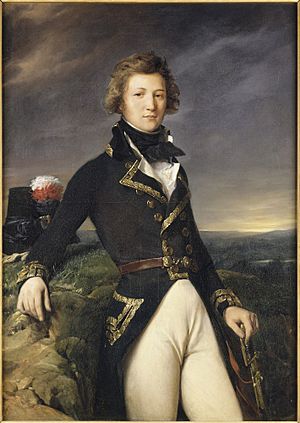
In June 1791, Louis Philippe got his first chance to serve France. He had been made a Colonel of the Chartres Dragoons in 1785. When war was about to start in 1791, all colonels were ordered to join their regiments.
Louis Philippe was a great officer and showed his bravery many times. Once, he saved two priests from an angry crowd. Another time, he jumped into a river to save a drowning engineer. For this, he received a special award. His regiment moved north to Flanders at the end of 1791.
He served under important officers who later became famous. These included Colonel Berthier and Lieutenant Colonel Alexandre de Beauharnais.
Battles and Promotions
France declared war on the Habsburg monarchy on April 20, 1792. Louis Philippe fought in the French Revolutionary Wars in what is now Belgium. He helped rally retreating soldiers and was praised by his commander. He was promoted to brigadier general.
In August 1792, Charles François Dumouriez took command of the Army of the North. Louis Philippe led a division under him. At the Battle of Valmy on September 20, 1792, Louis Philippe was ordered to place artillery on a hill. The battle ended without a clear winner, but the enemy army had to retreat. Dumouriez praised Louis Philippe's actions.
Louis Philippe was called back to Paris to report on the battle. He was promoted to lieutenant-general. In October, he returned to the army. On November 6, 1792, at the Battle of Jemappes, his division faced heavy losses. But Louis Philippe rallied his soldiers and helped defeat the Austrians.
Leaving France
Things in Paris became difficult for his military career. The army lacked supplies, and many soldiers were leaving. Louis Philippe did not like the more extreme policies of the French Republic. When the government decided to execute the deposed King, Louis Philippe thought about leaving France. He was very upset that his own father, who was called Philippe Égalité, voted for the King's execution.
Louis Philippe wanted to stay and do his duty in the army. But he became involved in a plan by Dumouriez to join with the Austrians, march on Paris, and bring back the old constitution. On April 4, 1793, Dumouriez and Louis Philippe left for the Austrian camp. They were seen as traitors by the French government.
To save his life, Louis Philippe decided to leave France. He was only nineteen years old and a lieutenant general. He would not return for 21 years.
Years in Exile (1793–1815)
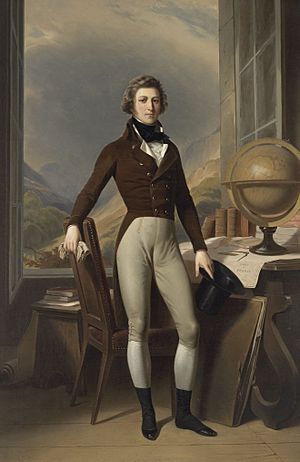
Because Louis Philippe was involved in Dumouriez's actions, his family faced problems in Paris. His father, Philippe Égalité, spoke out against his son. However, letters from Louis Philippe to his father were found and read to the government. His father and two younger brothers were then arrested.
Louis Philippe had to live secretly, avoiding both revolutionaries and French people who had fled France. He first went to Switzerland under a false name. The Swiss authorities told him to leave Zurich to protect their neutrality. He moved from town to town, often facing difficulties. He was even turned away from a monastery by monks who thought he was a young wanderer.
In October 1793, Louis Philippe found a job as a teacher. He taught geography, history, math, and languages at a boys' school in Reichenau, Switzerland. He used the name Monsieur Chabos. A month later, he heard terrible news: his father had been executed in Paris on November 6, 1793.
Traveling the World
After leaving Reichenau, Louis Philippe traveled a lot. He visited Scandinavia in 1795 and then went to Finland. For about a year, he lived in Muonio, a remote village in Lapland, staying with a local pastor.
Louis Philippe also visited the United States from about 1796 to 1798. He stayed in cities like Philadelphia, New York City, and Boston. In Boston, he taught French for a while. During his time in the U.S., Louis Philippe met important American leaders like George Washington.
He later said that his three years in the United States greatly influenced his political ideas when he became king. He and his brothers traveled widely, going as far south as Nashville and as far north as Maine.
In 1800, he and his brothers arrived in England, where they stayed for the next fifteen years. During this time, Louis Philippe taught math and geography at a school called the Great Ealing School.
Marriage and Family
In 1808, Louis Philippe asked to marry Princess Elizabeth of the United Kingdom, daughter of King George III of the United Kingdom. But because he was Catholic and her mother, Queen Charlotte, was against it, the Princess sadly said no.
In 1809, Louis Philippe married Princess Maria Amalia of Naples and Sicily. She was the daughter of King Ferdinand IV of Naples. The wedding took place in Palermo on November 25, 1809. This marriage was a bit controversial. Maria Amalia's younger aunt was Queen Marie Antoinette, and Louis Philippe's father was thought to have played a part in Marie Antoinette's execution. Maria Amalia's mother was against the marriage for this reason. But Louis Philippe convinced her that he wanted to make up for his father's mistakes.
Return to France (1815–1830)
After Napoleon gave up his power, Louis Philippe, now known as the Duke of Orléans, returned to France. This was during the time when his cousin Louis XVIII was king again. Louis Philippe had made peace with Louis XVIII while in exile.
However, Louis Philippe was still upset about how his family had been treated in the past. This caused problems between him and Louis XVIII. Louis Philippe openly supported the liberal opposition, who wanted more freedom and rights.
When Napoleon returned from exile in 1815, Louis Philippe and his family had to leave France again for England. After Napoleon was defeated at the Battle of Waterloo, Louis XVIII became king again. Louis Philippe and his family returned to France in 1817.
Louis Philippe got along better with Louis XVIII's brother and successor, Charles X, who became king in 1824. Charles X gave Louis Philippe the title of "Royal Highness." However, Louis Philippe's disagreement with Charles X's policies made him seem like a threat to the government. This later worked in his favor.
King of the French (1830–1848)
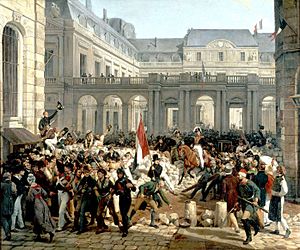
In 1830, the July Revolution led to Charles X being overthrown. Charles X gave up his throne for his 10-year-old grandson. Charles X named Louis Philippe "Lieutenant General of the Kingdom." He asked Louis Philippe to tell the elected Chamber of Deputies that his grandson should be the next king. But Louis Philippe did not do this, hoping to become king himself.
Because the Chamber knew Louis Philippe's liberal ideas and that he was popular, they declared him the new French king. This removed the older branch of the House of Bourbon from power. For eleven days before this, Louis Philippe had been acting as a temporary ruler for the young grandson.
Charles X and his family went into exile in the United Kingdom. Louis Philippe was sworn in as King Louis-Philippe I on August 9, 1830. He took the title "King of the French." This title showed that his rule was connected to the people, not just the land. This was different from the old title "King of France and of Navarre." This change was meant to weaken the claims of Charles X and his family.
In 1832, Louis Philippe's daughter, Princess Louise-Marie, married Leopold I, who became the first King of the Belgians. Their children include future Kings of the Belgians and Empress Carlota of Mexico.
His Rule as King
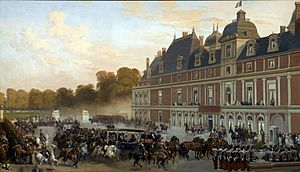
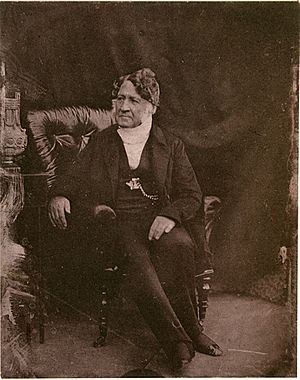
Louis Philippe ruled in a simple way, avoiding the fancy spending of earlier kings. He was supported by wealthy middle-class people, called the bourgeoisie. At first, people liked him a lot and called him the "Citizen King." But his popularity dropped as his government seemed to become more conservative.
His rule was different because it came from a revolution, not from a long family line. So, he looked to the glories of Napoleon I to strengthen his own rule. He supported bringing Napoleon's remains back to France. He also had Napoleon's statue put back on the Vendôme Column in 1833. The Arc de Triomphe, a monument to Napoleon's victories, was opened in 1836. Louis Philippe also created a national museum at the Château de Versailles, where famous battles were painted.
During his reign, the lives of working-class people got worse, and the gap between rich and poor grew. Louis Philippe's government was criticized for being too strict with those who disagreed and for favoring the rich.
In foreign affairs, it was a peaceful time. France became friends with Great Britain. In October 1844, Louis Philippe visited Queen Victoria at Windsor Castle. He was the first French king to visit England since 1356.
Louis Philippe faced opposition from groups like the Legitimists, who supported the older branch of the Bourbons, and the Republicans. In 1832, a terrible outbreak of cholera in Paris made people even more angry at the government. This led to a short uprising called the June Rebellion, which was quickly put down. Louis Philippe remained calm during this time, going to Paris to greet his troops and meet the people.
However, an economic downturn in 1846 led to the 1848 Revolutions. This forced Louis Philippe to give up his throne.
Assassination Attempts
Louis Philippe survived seven attempts to kill him.
On July 28, 1835, Giuseppe Mario Fieschi and two others tried to assassinate Louis Philippe in Paris. The king was riding along a street during a parade, with three of his sons and many staff members.
Fieschi, a former soldier, used a special weapon he built himself. It was called the Machine infernale and had 25 gun barrels that could fire at the same time. He fired it from the third floor of a building.
Eighteen people were killed, including several officers and civilians. Twenty-two more people were injured. The King and his sons were mostly unharmed. Fieschi was badly hurt and quickly caught. He was executed the next year along with his two partners.
Abdication and Final Years (1848–1850)
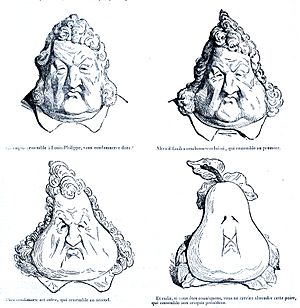
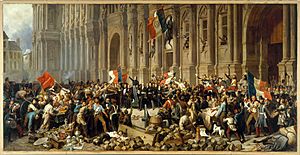
On February 24, 1848, during the February 1848 Revolution, King Louis Philippe gave up his throne. He did so in favor of his nine-year-old grandson, Philippe, comte de Paris. Louis Philippe was afraid of what had happened to the earlier King Louis XVI, who was executed. So, he quickly left Paris in disguise, using the name "Mr. Smith." He fled to England with his wife.
The French National Assembly first thought about accepting young Philippe as king. But public opinion was strongly against it. On February 26, the Second Republic was declared. Later, Louis Napoléon Bonaparte was elected president. He eventually declared himself Emperor Napoleon III in 1852.
Louis Philippe and his family lived in exile in Great Britain at Claremont, Surrey. Louis Philippe died there on August 26, 1850. He was first buried in Weybridge, Surrey. In 1876, his remains and his wife's were moved to France. They were buried at the Chapelle royale de Dreux, a special burial place for the Orléans family that his mother had built.
Royal Family Conflicts
The disagreements between the Legitimists (who supported the older Bourbon line) and the Orléanists (who supported Louis Philippe's family) continued in the 1870s. After the Second French Empire fell, a group of monarchists in the National Assembly offered the throne to the Legitimist claimant, Henri de France. Since he had no children, his heir would have been Louis Philippe's grandson, Philippe d'Orléans. This would have united the two branches of the family.
However, Henri de Chambord refused to become king unless the Tricolor flag of the Revolution was replaced with the old royal flag. The National Assembly would not agree to this. So, the Third Republic was established instead.
Today, some French monarchists still see the descendants of Louis Philippe's grandson as the rightful heirs to the French throne. Others, the Legitimists, believe that Don Luis-Alfonso de Borbón is the rightful heir.
Honors and Awards
From France
| Silver coin of Louis Philippe I, struck 1834 | |
|---|---|
 |
|
| Obverse: (French) LOUIS PHILIPPE I, ROI DES FRANÇAIS, in English: "Louis Philippe I, King of the French" | Reverse: 5 FRANCS, 1834 |
- Knight of the Holy Spirit (February 2, 1789)
- Grand Cross of the Legion of Honour (July 3, 1816); Grand Master (August 9, 1830)
- Grand Cross of the Military Order of St. Louis (July 10, 1816)
- Founder and Grand Master of the Order of the Cross of July (December 13, 1830)
From Other Countries
 Belgium: Grand Cordon of the Order of Leopold (March 10, 1833)
Belgium: Grand Cordon of the Order of Leopold (March 10, 1833) Denmark: Knight of the Elephant (April 30, 1846)
Denmark: Knight of the Elephant (April 30, 1846) Netherlands: Grand Cross of the Military William Order (March 22, 1842)
Netherlands: Grand Cross of the Military William Order (March 22, 1842) Spain: Knight of the Golden Fleece (February 21, 1834)
Spain: Knight of the Golden Fleece (February 21, 1834) Two Sicilies: Knight of St. Januarius and Grand Cross of St. Ferdinand and Merit
Two Sicilies: Knight of St. Januarius and Grand Cross of St. Ferdinand and Merit United Kingdom: Stranger Knight of the Garter (October 11, 1844)
United Kingdom: Stranger Knight of the Garter (October 11, 1844)
Symbols of His Reign
Places Named After Him
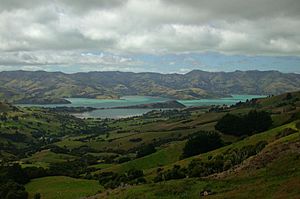
Port Louis-Philippe (Akaroa), the oldest French colony in the South Pacific, was named after Louis Philippe. It is now called Akaroa in New Zealand. This town was founded on August 18, 1840, when Louis Philippe was King of the French. He strongly supported this settlement project.
The ship that carried the settlers to Port Louis-Philippe was named the Comte de Paris. This was in honor of Louis Philippe's young grandson, Prince Philippe, Count of Paris, who was born in 1838.
His Children
| Name | Picture | Birth | Death | Notes |
|---|---|---|---|---|
| Ferdinand Philippe, Duke of Orléans | 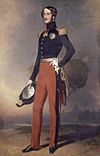 |
September 3, 1810 | July 13, 1842 | Married Duchess Helene of Mecklenburg-Schwerin, had children. |
| Louise d'Orléans | 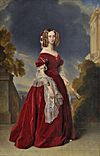 |
April 3, 1812 | October 11, 1850 | Married King Leopold I of Belgium, had children. |
| Princess Marie d'Orléans | 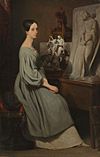 |
April 12, 1813 | January 6, 1839 | Married Duke Alexander of Württemberg, had children. |
| Louis, Duke of Nemours | 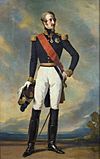 |
October 25, 1814 | June 26, 1896 | Married Princess Victoria of Saxe-Coburg and Gotha, had children. |
| Princess Françoise Louise Caroline d'Orléans |  |
March 26, 1816 | May 20, 1818 | Died at age two. |
| Clémentine d'Orléans | 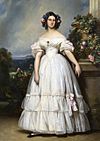 |
March 6, 1817 | February 16, 1907 | Married Prince August of Saxe-Coburg and Gotha, had children. |
| François, Prince of Joinville | 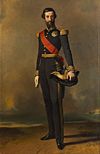 |
August 14, 1818 | June 16, 1900 | Married Princess Francisca of Brazil, had children. |
| Charles d'Orléans |  |
January 1, 1820 | July 25, 1828 | Died at age eight. |
| Henri, Duke of Aumale | 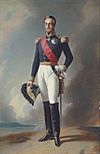 |
January 16, 1822 | May 7, 1897 | Married Princess Caroline Auguste of the Two Sicilies, had children, but no descendants survived. |
| Antoine, Duke of Montpensier | 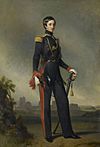 |
July 31, 1824 | February 4, 1890 | Married Infanta Luisa Fernanda, Duchess of Montpensier, had children. |
Images for kids
See also
 In Spanish: Luis Felipe I de Francia para niños
In Spanish: Luis Felipe I de Francia para niños
- Louis Philippe style
- List of works by James Pradier
- Paris under Louis-Philippe
- Lieutenant-General (France)
- Origins of the French Foreign Legion
- Port Louis-Philippe (Akaroa)
Namesakes
- Louis Philippe, Crown Prince of Belgium (1833–1834), grandson by his daughter Queen Louise of the Belgians
- Luís Filipe, Prince Royal of Portugal (1887–1908), great-great-grandson and heir to the Portuguese Throne


